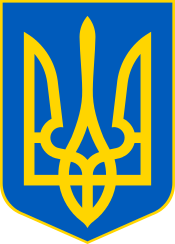East Slavs
The East Slavs are Slavic peoples speaking the East Slavic languages. Formerly the main population of the loose medieval Kievan Rus federation state [2], by the seventeenth century they evolved into the Belarusian, Russian, Rusyn and Ukrainian[3] people.
 Countries with predominantly East Slavic population | |
| Total population | |
|---|---|
| 200+ million | |
| Regions with significant populations | |
| Majority: Belarus, Russia, Ukraine Minority: Baltics (Estonia, Latvia, Lithuania), Serbia, Caucasus (Azerbaijan, Georgia), Moldova, other former Soviet states. | |
| Languages | |
| East Slavic languages: Belarusian, Russian, Rusyn, Ukrainian | |
| Related ethnic groups | |
| Other Slavs |
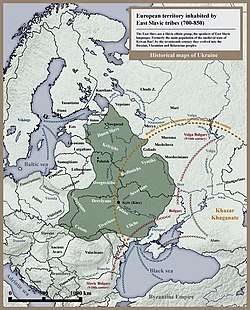
History
Sources
Researchers know relatively little about the Eastern Slavs prior to approximately 859 AD, when the first events recorded in the Primary Chronicle occurred. The Eastern Slavs of these early times apparently lacked a written language. The few known facts come from archaeological digs, foreign travellers' accounts of the Rus' land, and linguistic comparative analyses of Slavic languages.
Very few native Rus' documents dating before the 11th century (none before the 10th century) have survived. The earliest major manuscript with information on Rus' history, the Primary Chronicle, dates from the late 11th and early 12th centuries. It lists twelve Slavic tribal unions which, by the 10th century, had settled in the later territory of the Kievan Rus between the Western Bug, the Dniepr and the Black Sea: the Polans, Drevlyans, Dregovichs, Radimichs, Vyatichs, Krivichs, Slovens, Dulebes (later known as Volhynians and Buzhans), White Croats, Severians, Ulichs, and Tivertsi.
Migration
There is no consensus among scholars as to the urheimat of the Slavs. In the first millennium AD, Slavic settlers are likely to have been in contact with other ethnic groups who moved across the East European Plain during the Migration Period. Between the first and ninth centuries, the Sarmatians, Huns, Alans, Avars, Bulgars, and Magyars passed through the Pontic steppe in their westward migrations. Although some of them could have subjugated the region's Slavs, these foreign tribes left little trace in the Slavic lands. The Early Middle Ages also saw Slavic expansion as an agriculturist and beekeeper, hunter, fisher, herder, and trapper people. By the 8th century, the Slavs were the dominant ethnic group on the East European Plain.
By 600 AD, the Slavs had split linguistically into southern, western, and eastern branches. The East Slavs practiced "slash-and-burn" agricultural methods which took advantage of the extensive forests in which they settled. This method of agriculture involved clearing tracts of forest with fire, cultivating it and then moving on after a few years. Slash and burn agriculture requires frequent movement, because soil cultivated in this manner only yields good harvests for a few years before exhausting itself, and the reliance on slash and burn agriculture by the East Slavs explains their rapid spread through eastern Europe.[4] The East Slavs flooded Eastern Europe in two streams. One group of tribes settled along the Dnieper river in what is now Ukraine and Belarus to the North; they then spread northward to the northern Volga valley, east of modern-day Moscow and westward to the basins of the northern Dniester and the Southern Buh rivers in present-day Ukraine and southern Ukraine.
Another group of East Slavs moved to the northeast, where they encountered the Varangians of the Rus' Khaganate and established an important regional centre of Novgorod. The same Slavic population also settled the present-day Tver Oblast and the region of Beloozero. Having reached the lands of the Merya near Rostov, they linked up with the Dnieper group of Slavic migrants.
Pre-Kievan period
In the eighth and ninth centuries, the south branches of East Slavic tribes had to pay tribute to the Khazars, a Turkic-speaking people who adopted Judaism in the late eighth or ninth century and lived in the southern Volga and Caucasus regions. Roughly in the same period, the Ilmen Slavs and Krivichs were dominated by the Varangians of the Rus' Khaganate, who controlled the trade route between the Baltic Sea and the Byzantine Empire.
The earliest tribal centres of the East Slavs included Novgorod, Izborsk, Polotsk, Gnezdovo, and Kiev. Archaeology indicates that they appeared at the turn of the tenth century, soon after the Slavs and Finns of Novgorod had rebelled against the Norse and forced them to withdraw to Scandinavia. The reign of Oleg of Novgorod in the early tenth century witnessed the return of the Varangians to Novgorod and relocation of their capital to Kiev on the Dnieper. From this base, the mixed Varangian-Slavic population (known as the Rus) launched several expeditions against Constantinople.
At first the ruling elite was primarily Norse, but it was rapidly Slavicized by the mid-century. Sviatoslav I of Kiev (who reigned in the 960s) was the first Rus ruler with a Slavonic name.
Post-Kievan period
The disintegration, or parcelling of the polity of Kievan Rus' in the 11th century resulted in considerable population shifts and a political, social, and economic regrouping. The resultant effect of these forces coalescing was the marked emergence of new peoples.[5] While these processes began long before the fall of Kiev, its fall expedited these gradual developments into a significant linguistic and ethnic differentiation among the Rus' people into Ukrainians, Belarusians, and Russians.[5] All of this was emphasized by the subsequent polities these groups migrated into: southwestern and western Rus', where the Ruthenian and later Ukrainian and Belarusian identities developed, was subject to Lithuanian and later Polish influence;[6] whereas the Russian ethnic identity developed in the Muscovite northeast and the Novgorodian north.
Modern East Slavs
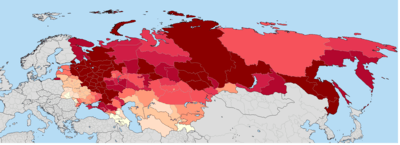
Modern East Slavic peoples and ethnic/subethnic groups include:
Image gallery
 Three generations of a Russian family, ca. 1910
Three generations of a Russian family, ca. 1910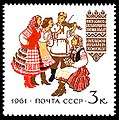 Belarusians in traditional dress
Belarusians in traditional dress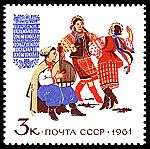 Ukrainians in traditional dress
Ukrainians in traditional dress
_Commanding_Officer%2C_Capt._Leo_Goff_participates_in_a_welcoming_ceremony_on_the_pier.jpg) Bread and salt greeting ceremony in Vladivostok, Russia
Bread and salt greeting ceremony in Vladivostok, Russia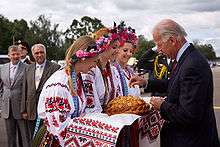 Bread and salt greeting ceremony in Kyiv, Ukraine
Bread and salt greeting ceremony in Kyiv, Ukraine
See also
- All-Russian nation
- List of early East Slavic states
- List of medieval Slavic tribes
- South Slavs
- West Slavs
References
Citations
- Oscar Halecki. (1952). Borderlands of Western Civilization. New York: Ronald Press Company. pp. 45-46
- John Channon & Robert Hudson, Penguin Historical Atlas of Russia (Penguin, 1995), p.16.
- "Slav | History & Facts". Encyclopedia Britannica. Retrieved 2020-01-05.
- Richard Pipes. (1995). Russia Under the Old Regime. New York: Penguin Books. pp. 27-28
- Riasanovsky, Nicholas; Steinberg, Mark D. (2005). A History of Russia (7th ed.). New York: Oxford University Press. pp. 61, 87.
- Magocsi, Paul Robert (2010). A History of Ukraine: A Land and Its Peoples. Toronto: University of Toronto Press. p. 73.
Sources


